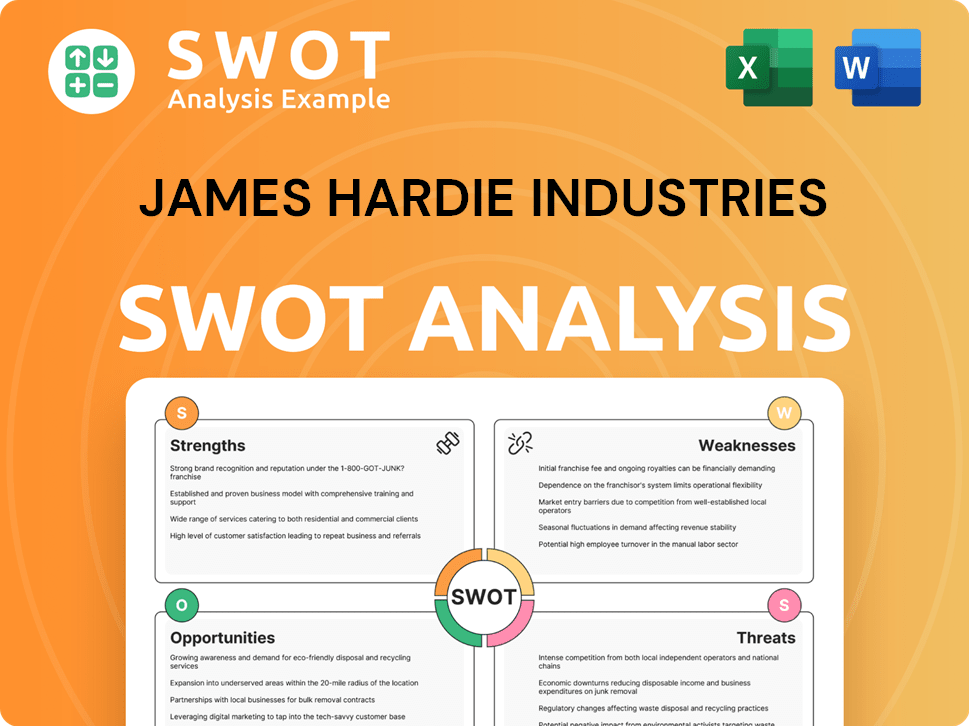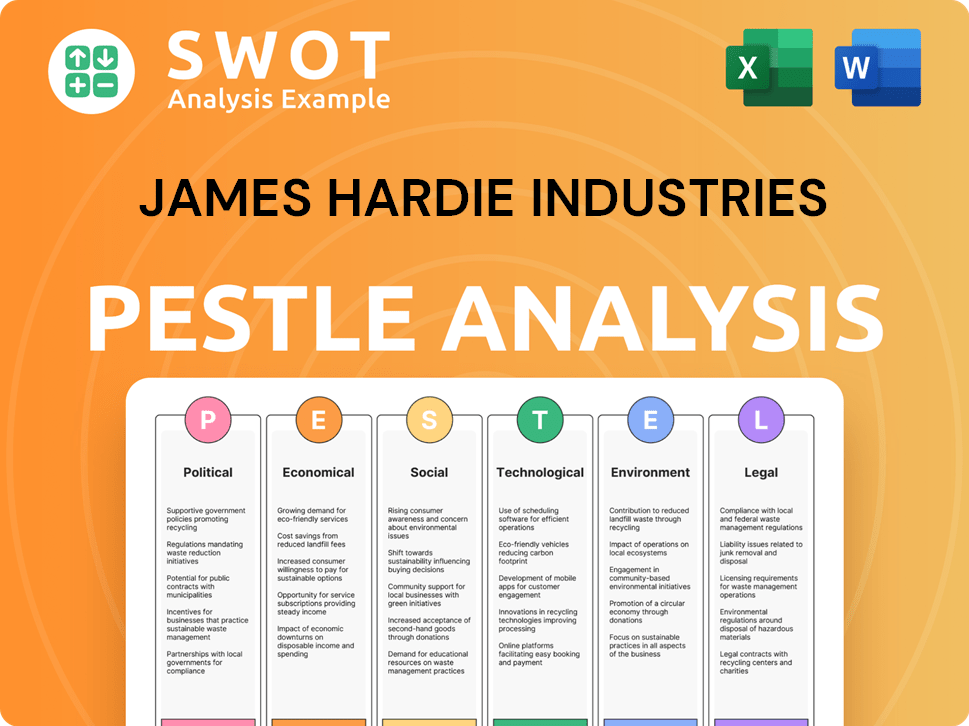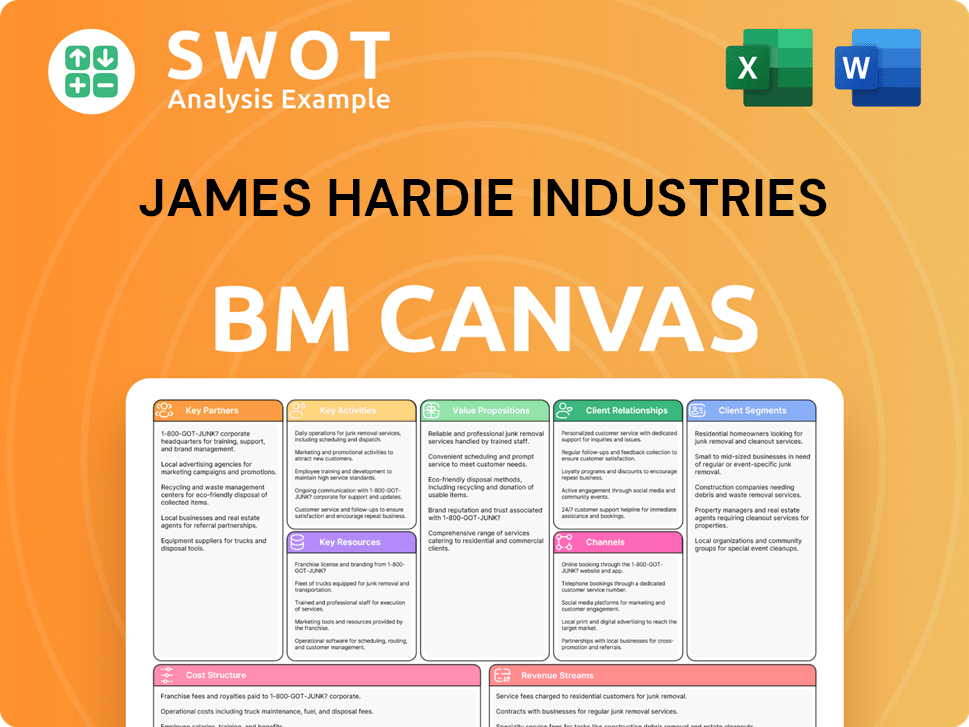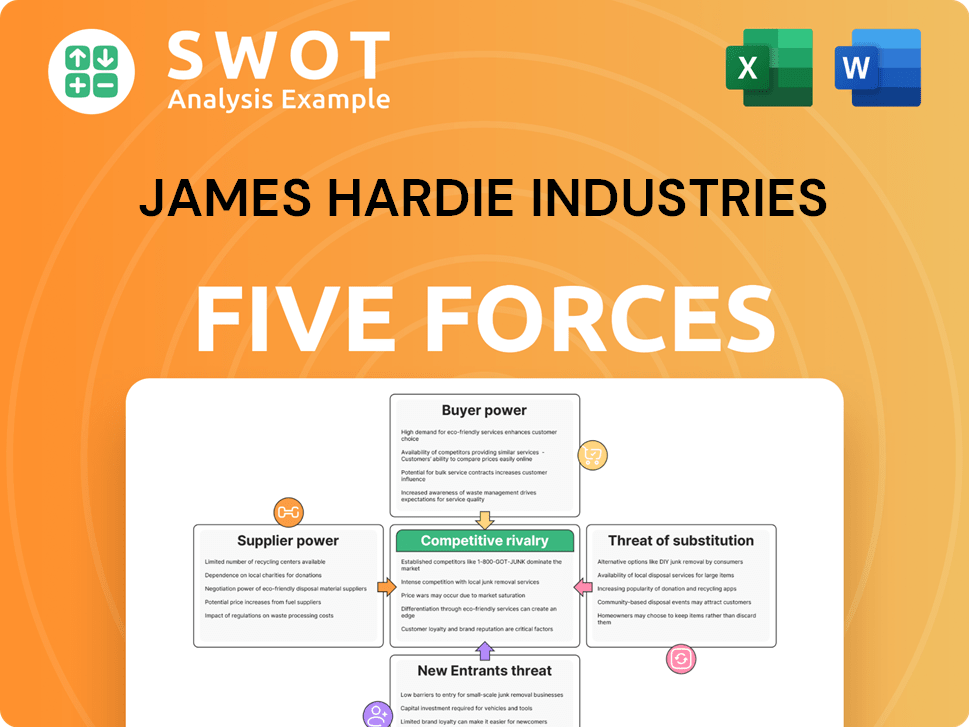James Hardie Industries Bundle
What's the Story Behind James Hardie's Success?
Ever wondered how a company becomes a global leader in building materials? James Hardie Industries, a name synonymous with durability and innovation, has a fascinating history. From its humble beginnings in 1888, this company has transformed the construction industry. Discover the evolution of James Hardie Industries SWOT Analysis and its journey to becoming a building solutions giant.

The early history of James Hardie Industries reveals a story of adaptation and strategic growth. James Hardie's early focus on importing quickly evolved, leading to the groundbreaking development of fiber cement technology in the 1980s. This innovation, along with the company's commitment to quality, propelled James Hardie from a local Australian business to a multinational corporation, revolutionizing the use of building materials like Hardie board and solidifying its place in the construction industry.
What is the James Hardie Industries Founding Story?
The story of James Hardie Industries begins in 1888, a testament to entrepreneurial spirit and adaptability. James Hardie, a Scottish immigrant, laid the foundation for what would become a global leader in building materials. His journey from importing goods to pioneering innovative construction solutions is a compelling narrative of business evolution.
James Hardie's initial venture focused on importing various products, reflecting the needs of a growing Australian market. This early focus on essential commodities set the stage for the company's later diversification and innovation in the building materials sector. The company's history is a blend of market responsiveness and strategic foresight.
James Hardie Industries was founded on January 17, 1888, by James Hardie, a Scottish immigrant who arrived in Melbourne, Australia, in 1888. Hardie, originally from Glasgow, Scotland, initially established a business focused on importing various products, including oils, leathers, and tanning materials. The initial problem or opportunity identified by Hardie was the demand for imported goods in a rapidly developing colonial Australia. His original business model was that of a merchant and importer, supplying a range of essential commodities to the burgeoning market.
James Hardie's early business was built on importing goods to meet the demands of a growing Australian market. His Scottish background and experience as a merchant were instrumental in identifying and capitalizing on market opportunities.
- The company's initial funding likely came from self-financing and traditional banking channels.
- The late 19th-century Australian context, marked by population growth and infrastructure development, provided a fertile ground for businesses like Hardie's.
- The company's name, reflecting its founder, highlights the personal drive behind its establishment.
- The early focus was on supplying essential commodities, setting the stage for future diversification.
The company's initial funding was likely self-financed or through traditional banking channels available to merchants at the time, common for early businesses in the late 19th century. James Hardie's background as a successful merchant in Scotland provided him with the commercial acumen to identify and capitalize on market needs in his new home. The cultural and economic context of late 19th-century Australia, characterized by significant population growth and infrastructure development, provided fertile ground for businesses like Hardie's, which supplied crucial materials to a growing economy. The company's name directly reflects its founder, a common practice for businesses established by individuals with strong entrepreneurial drive.
James Hardie Industries SWOT Analysis
- Complete SWOT Breakdown
- Fully Customizable
- Editable in Excel & Word
- Professional Formatting
- Investor-Ready Format

What Drove the Early Growth of James Hardie Industries?
The early growth and expansion of James Hardie Industries, from its import business origins, was a pivotal period. The company's strategic shift towards manufacturing building materials, particularly with the introduction of asbestos cement products, marked a significant turning point. This move capitalized on the growing construction industry in Australia. The company's early history is marked by key milestones and strategic decisions that shaped its future.
In 1903, Andrew Reid joined James Hardie Industries, and his influence became increasingly important, especially after James Hardie's retirement in 1911. Under Reid's leadership, the company recognized the growing demand for building materials. A key development was the introduction of asbestos cement products in 1917, marking the company's entry into manufacturing. This strategic move was a pivot from its import-focused model.
The company's focus on manufacturing building materials led to early product launches such as flat and corrugated asbestos cement sheets. These products quickly gained traction in the market due to their durability and affordability. Initial team expansion centered around the manufacturing process and distribution networks to support these new products. The early history of James Hardie Industries shows a commitment to domestic production.
Throughout the mid-20th century, James Hardie continued to expand its product offerings and geographical reach within Australia and New Zealand. Major capital raises and leadership transitions occurred as the company grew, adapting to changing market demands and technological advancements. The market reception for their building materials was strong, driven by post-war construction booms.
The competitive landscape, while present, saw James Hardie establish a dominant position due to its early entry and product quality. This period of early growth and expansion laid the foundation for the company's future innovations and internationalization. To learn more about the company's marketing strategies, you can read about the Marketing Strategy of James Hardie Industries.
James Hardie Industries PESTLE Analysis
- Covers All 6 PESTLE Categories
- No Research Needed – Save Hours of Work
- Built by Experts, Trusted by Consultants
- Instant Download, Ready to Use
- 100% Editable, Fully Customizable

What are the key Milestones in James Hardie Industries history?
The story of James Hardie Industries is marked by significant milestones, from its early beginnings to its current status as a global leader in building materials. The company's journey includes strategic shifts, technological advancements, and responses to major industry challenges, shaping its trajectory over more than a century. Exploring the Mission, Vision & Core Values of James Hardie Industries provides further insight into the company's ethos and future direction.
| Year | Milestone |
|---|---|
| 1888 | The company was founded in Melbourne, Australia, initially focused on importing and distributing building materials. |
| Early 1900s | Expanded into manufacturing, including asbestos-cement products, which became a significant part of its business. |
| 1980s | Pioneered and commercialized fiber cement technology, a critical innovation in response to health concerns related to asbestos. |
| 1990s-2000s | Faced significant legal and financial challenges due to asbestos liabilities, leading to restructuring and the establishment of a compensation fund. |
| 2003 | Relocated its corporate headquarters to Dublin, Ireland, to manage asbestos liabilities and expand globally. |
| 2010s-2020s | Continued to expand its global footprint, particularly in North America and Europe, establishing itself as a world leader in fiber cement building solutions. |
The company's commitment to innovation is evident in its development of fiber cement products, which offered superior durability and versatility. These innovations led to the creation of Hardie board, a product that has become a staple in the construction industry, enhancing the company's reputation for quality and performance.
The development of fiber cement was a groundbreaking innovation, providing a safer alternative to asbestos-containing materials. This technology enabled the creation of durable and versatile building materials, including siding and other products.
A key innovation was the transition to asbestos-free products, addressing health concerns and setting new industry standards. This shift demonstrated the company's commitment to product safety and environmental responsibility.
The introduction of Hardie board, a fiber cement siding product, revolutionized the construction industry. It provided a durable, low-maintenance alternative to traditional siding materials.
Continuous improvements in manufacturing processes have led to enhanced product quality and efficiency. These advancements have helped the company maintain its competitive edge in the market.
Ongoing research and development have resulted in product enhancements, including improved fire resistance, durability, and aesthetic options. These improvements cater to evolving customer needs and market demands.
The company has increasingly focused on sustainable practices, including the use of recycled materials and energy-efficient manufacturing processes. This commitment supports environmental responsibility and helps meet sustainability goals.
The company has faced numerous challenges, most notably the asbestos crisis, which resulted in significant legal and financial burdens. Despite these past difficulties, James Hardie Industries has demonstrated resilience and adapted its strategies to maintain its position in the market.
The historical use of asbestos in its products led to substantial legal and financial liabilities. This crisis prompted significant restructuring and the establishment of a compensation fund to address claims.
Economic downturns and fluctuations in the construction industry have presented challenges to sales and profitability. The company has had to adapt its strategies to navigate these market conditions.
Intense competition from other building materials manufacturers has required continuous innovation and cost management. The company has needed to differentiate its products to maintain market share.
Disruptions in the global supply chain, particularly during the COVID-19 pandemic, have impacted the availability of raw materials and increased production costs. The company has had to manage these challenges to maintain operations.
Changes in building codes and environmental regulations have required the company to adapt its products and manufacturing processes. Staying compliant with these regulations is crucial for market access.
Managing public perception, particularly in relation to past asbestos liabilities, has been an ongoing challenge. The company has focused on transparency and responsible practices to rebuild trust.
James Hardie Industries Business Model Canvas
- Complete 9-Block Business Model Canvas
- Effortlessly Communicate Your Business Strategy
- Investor-Ready BMC Format
- 100% Editable and Customizable
- Clear and Structured Layout

What is the Timeline of Key Events for James Hardie Industries?
The story of James Hardie Industries is one of evolution and adaptation. From its origins as an import business to its current status as a global leader in building materials, the company has navigated significant shifts in the industry and the broader market. Key milestones highlight the company's strategic pivots, technological advancements, and expansion into new markets, shaping its identity and impact on the construction sector.
| Year | Key Event |
|---|---|
| 1888 | James Hardie establishes an import business in Melbourne, Australia, marking the beginning of the company's journey. |
| 1903 | Andrew Reid joins the company, beginning a period of strategic evolution and setting the stage for future growth. |
| 1911 | James Hardie retires, and Andrew Reid assumes leadership, steering the company through significant changes. |
| 1917 | The company begins manufacturing asbestos cement products, a pivotal move in its early history. |
| 1980s | James Hardie pioneers and commercializes asbestos-free fiber cement technology, a major technological advancement. |
| 1986 | The company enters the North American market, initiating a period of international expansion and growth. |
| 1990s | Significant international expansion, particularly in the United States, solidifying its global presence. |
| 2001 | James Hardie Industries N.V. is incorporated in the Netherlands, becoming the parent company and restructuring its corporate structure. |
| 2000s | Establishment of the Asbestos Injuries Compensation Fund (AICF) to manage asbestos liabilities, addressing past issues. |
| 2010s | Continued focus on innovation in fiber cement products and market diversification, reinforcing its product portfolio. |
| 2020s | Emphasis on sustainable building solutions and advanced manufacturing technologies, reflecting a commitment to modern trends. |
James Hardie Industries aims to increase its market share, focusing on North America and Europe. This expansion strategy involves leveraging its existing brand recognition and the high performance of its products like Hardie board. The company is also exploring opportunities in emerging markets to diversify its revenue streams and reduce its reliance on specific geographic regions. In 2024, the North American market accounted for a significant portion of James Hardie's revenue, showcasing its importance.
Innovation is central to James Hardie's strategy. The company is developing new fiber cement and fiber gypsum solutions. These new products are designed to offer better performance, easier installation, and environmental benefits. Research and development efforts are focused on improving insulation and fire resistance, aligning with current building codes and consumer demands. In 2024, James Hardie invested a considerable amount in R&D to improve its product offerings.
James Hardie is committed to sustainability, and it is focusing on eco-friendly building materials and practices. The company is working to reduce its carbon footprint and promote sustainable construction. Sustainable building materials are becoming more critical in the construction industry. James Hardie has been actively pursuing initiatives to minimize its environmental impact. The company is also exploring the use of recycled materials in its products.
Operational efficiency is a key focus for James Hardie to enhance its profitability and competitiveness. This includes supply chain optimization and strategic acquisitions to strengthen its market position. The company is continually improving its manufacturing processes to reduce costs and increase efficiency. James Hardie's focus on operational excellence has been key to its financial performance. The company's ability to manage costs effectively is crucial for its long-term success.
James Hardie Industries Porter's Five Forces Analysis
- Covers All 5 Competitive Forces in Detail
- Structured for Consultants, Students, and Founders
- 100% Editable in Microsoft Word & Excel
- Instant Digital Download – Use Immediately
- Compatible with Mac & PC – Fully Unlocked

Related Blogs
- What is Competitive Landscape of James Hardie Industries Company?
- What is Growth Strategy and Future Prospects of James Hardie Industries Company?
- How Does James Hardie Industries Company Work?
- What is Sales and Marketing Strategy of James Hardie Industries Company?
- What is Brief History of James Hardie Industries Company?
- Who Owns James Hardie Industries Company?
- What is Customer Demographics and Target Market of James Hardie Industries Company?
Disclaimer
All information, articles, and product details provided on this website are for general informational and educational purposes only. We do not claim any ownership over, nor do we intend to infringe upon, any trademarks, copyrights, logos, brand names, or other intellectual property mentioned or depicted on this site. Such intellectual property remains the property of its respective owners, and any references here are made solely for identification or informational purposes, without implying any affiliation, endorsement, or partnership.
We make no representations or warranties, express or implied, regarding the accuracy, completeness, or suitability of any content or products presented. Nothing on this website should be construed as legal, tax, investment, financial, medical, or other professional advice. In addition, no part of this site—including articles or product references—constitutes a solicitation, recommendation, endorsement, advertisement, or offer to buy or sell any securities, franchises, or other financial instruments, particularly in jurisdictions where such activity would be unlawful.
All content is of a general nature and may not address the specific circumstances of any individual or entity. It is not a substitute for professional advice or services. Any actions you take based on the information provided here are strictly at your own risk. You accept full responsibility for any decisions or outcomes arising from your use of this website and agree to release us from any liability in connection with your use of, or reliance upon, the content or products found herein.